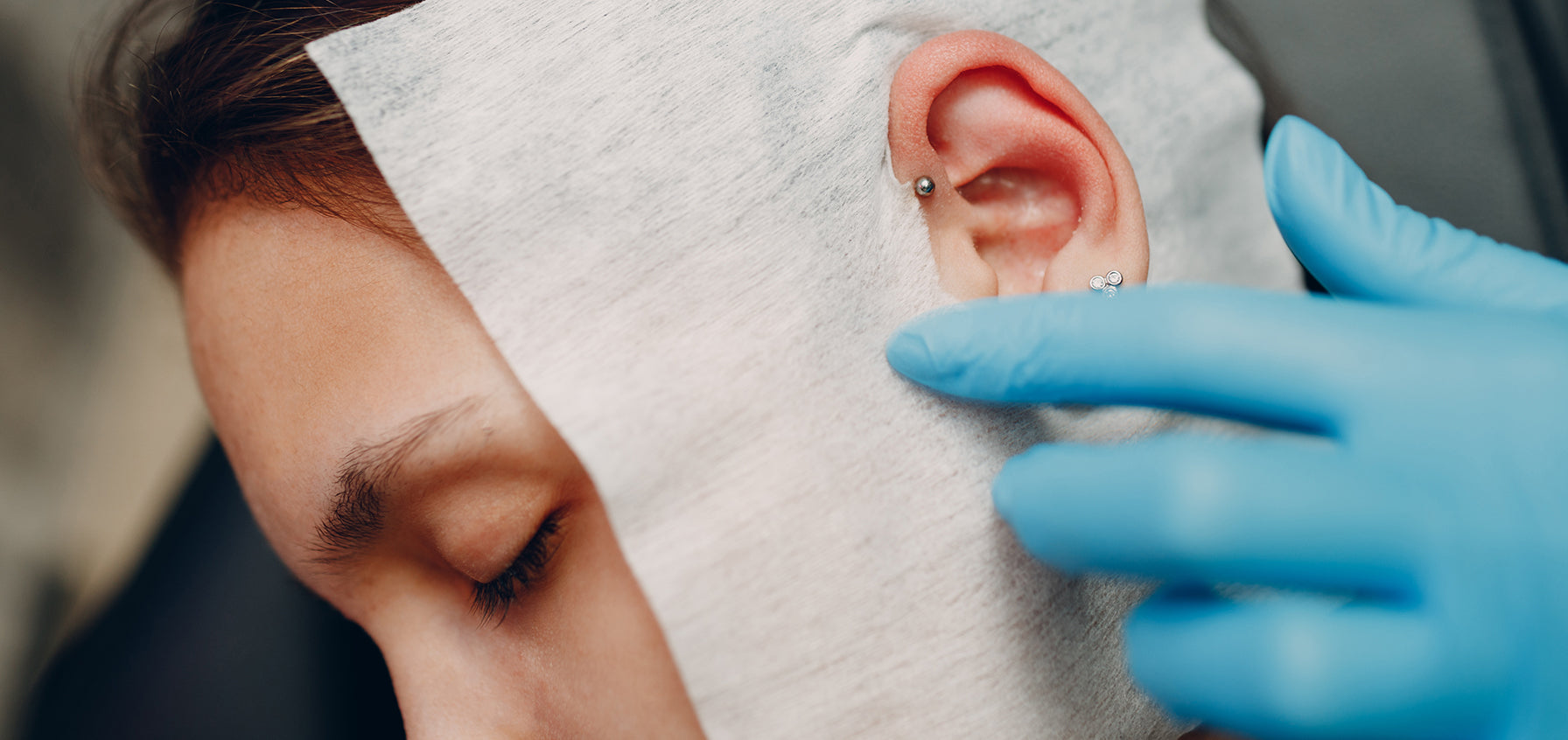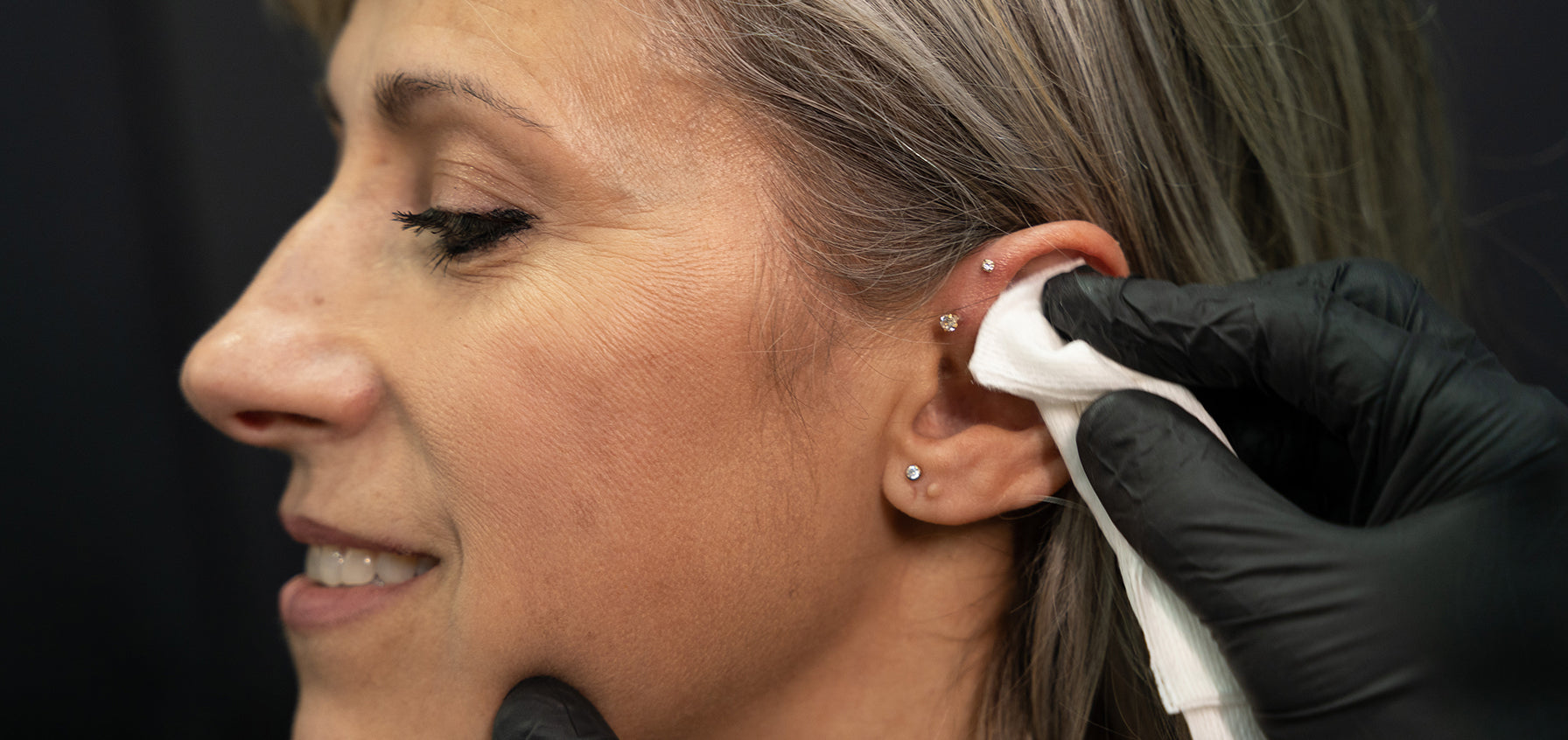Why Forward Helix Piercings Are On Every Piercing Trends List
Forward helix piercings became popular after Chrissy Shull's black-and-white picture of a triple forward helix piercing went viral on Pinterest a few years ago. They’ve remained trendy ever since, partially because of the variety of jewelry options.
Understanding Forward Helix Piercings
A forward helix piercing goes through the ridge of cartilage above the tragus that curls and connects to the face. It’s important to know that everybody has different anatomy, and this is an anatomy-dependent piercing. Therefore, you may not have suitable anatomy for a triple forward helix, but you could do a single or double. You may have the anatomy for four or five forward helix piercings. It’s best to visit your piercer for a consultation and to go in with an open mind.
In addition to needing enough tissue to pierce through, the ridge must also allow enough space for jewelry. Sometimes, other structures in the ear, like the ridge a rook piercing goes through, can prevent enough space for jewelry to sit comfortably at the proper angle.

If you wear glasses or masks, tell your piercer and bring them with you. Your piercer may ask you to put them on so they can position the piercings so they are least affected by pressure from glasses or mask straps.
Depending on your anatomy, the backside of the jewelry may be more visible. This is something to take into consideration when thinking about the overall aesthetic of your ears.
Pain and Healing Process
Everybody has different pain tolerances, and pain is relative, so it’s impossible to predict how much pain the piercing process will cause you. Additionally, the pain depends on how many you’re getting done. It won't be too bad if it’s just one forward helix piercing. But if you’re getting multiple, the pain will increase with each new piercing.
The forward helix is also a piercing with a varying healing timeline. If you get just one forward helix piercing with a labret stud for your initial jewelry, it should take three to six months to heal. However, if you decide to get a double, triple, or quadruple forward helix piercing, it will take longer. The more you get, the longer it will take to heal; the total timeline could be at least a year or longer.

The healing time is much longer the more you get because this is generally a tiny surface area. When three piercings try to heal in such a small area, the swelling will affect each piercing, and the swelling from one piercing will put additional pressure on the others.
The Aftercare Process
The forward helix is more difficult to heal than other piercings, especially the more you get.
First, you will need to clean it at least twice a day with a saline solution spray, like the ones made by NeilMed or H2Ocean. However, because the forward helix can be in a tight area where it’s hard to reach the backside of the piercing, it can be difficult to keep fully clean. A good tip is to use the pointy makeup Q tips if you need to clean the jewelry from crusties.
Additionally, this area is prone to hair getting caught or snagged in the jewelry. Baby hairs tend to grow in this area, and depending on the length and texture of your hair, they can get caught in the jewelry, which can irritate the piercing. You also need to be careful when brushing your hair so it doesn’t snag.
In addition to not touching your piercing, especially if you haven’t washed your hands first, you should avoid sleeping on it and wearing over-the-ear headphones. Anything that puts unnecessary pressure on the jewelry can cause it to change how it sits in the piercing hole. The last thing you want to happen is for the jewelry angle to slant. If this happens, and you have multiple forward helix piercings, their alignment may not look as good as it once did.
If you wear glasses or masks, you must be careful taking them off.
Perhaps one of the most important parts of the aftercare process, aside from cleaning the piercing, is downsizing it. When you’re initially pierced, the jewelry will be longer than necessary to accommodate swelling. Once the swelling has completely subsided (generally 6-8 weeks), you can visit your piercer to have it downsized for something more fitted.
Wearing too long jewelry can also cause the way the jewelry rests in the piercing to misalign, which can disrupt the overall look if you have multiple forward helix piercings.
Jewelry Options for a Forward Helix Piercing
Types
The recommended jewelry for healing your forward helix piercing is a labret stud. There are two types you can use: threadless and threaded. Threadless is easier to deal with because it just requires pressure to get the end on and has better chances of staying in place. Threaded means the end can come unscrewed and fall off. You also need to be able to grip the disc to hold it steady, and depending on anatomy, the disc may not always be easily accessible.
Once your piercing has fully healed, you can wear a clicker, seamless ring, or captive bead ring in it. You’ll have to find jewelry with a small enough diameter to comfortably fit the area.
One of the main draws of getting a forward helix piercing, especially multiples, is the variety of jewelry options. You can wear all studs, all rings, or even one (or more) of each.
The different ends for labret studs also make the jewelry options seem endless. You can create a completely monochromatic look by choosing the same color and setting of a gem. Depending on how many you have, you can create a rainbow of sorts. And now, there are even shapes that can make unique and artistic statements about your personal style, interests, and aesthetics. However, smaller jewelry does work best.
Materials
When you’re initially pierced, a reputable piercer will know only to use implant-grade steel, implant-grade titanium, or gold jewelry. These materials are known to be body-safe and allergen-free.
Lower-quality jewelry can contain ingredients that people are commonly allergic to, such as nickel. This can cause your skin to react and irritate the piercing. Additionally, lower-quality materials are known to discolor or have their coatings flake off. That’s why it’s always best to invest in quality, safe body jewelry.
Overall, the forward helix piercing may take more time to heal and need more maintenance as it heals fully, but the reward is how much freedom and fun you can create jewelry combinations if you get more than one. If you just get one, that doesn’t mean you’re boring or missing out. The forward helix piercing can be part of an ear curation with other piercings, or you can pair it with a different cartilage piercing.


